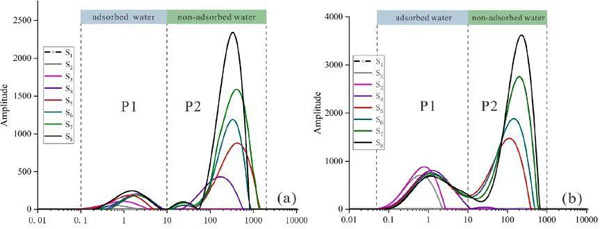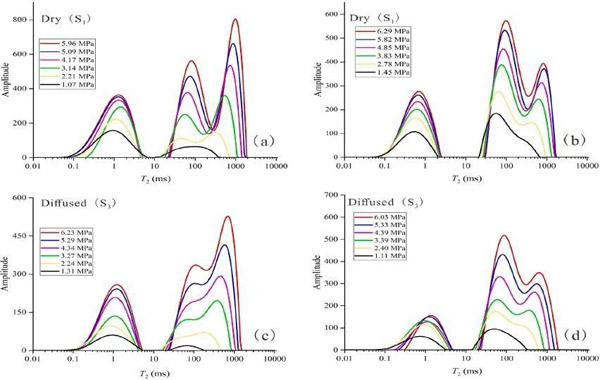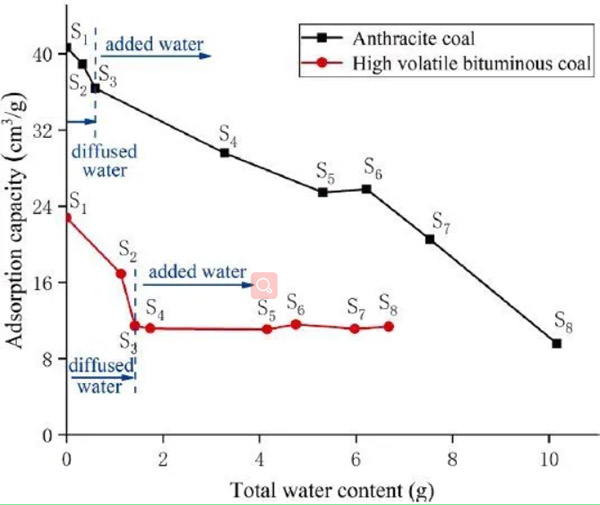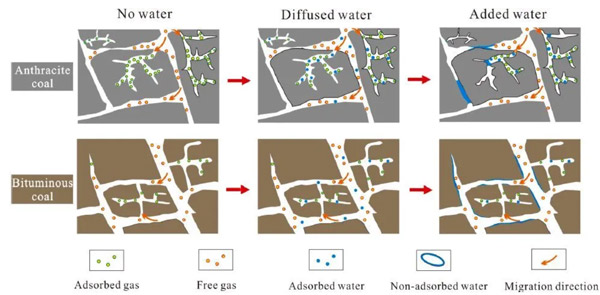Discussion
1 .The peak change of nuclear magnetic spectrum of water
The first is the change in the spectral peak of water. From S2 to S3, only peak P1 with relaxation time between 0.1ms and 10ms appeared, which was caused by water molecules evaporated from the solution diffusing into the coal and finally adsorbed in the tiny pores. Since S4, peak P2 with a relaxation time of more than 10ms appeared and continued to increase significantly with the increase in the amount of water added. The obvious difference of water transport reflected from the nuclear magnetic spectrum peak proves that the diffusion water stage and the drip water stage correspond to the adsorbed water and the non-adsorbed water respectively.

2 .The peak change of nuclear magnetic spectrum of gas
After understanding the water migration mode, we pay more attention to the influence of water entry on gas.
The four pictures on the left of the figure below show high-rank coal, while the one on the right shows low-rank coal. A and b are the drying contrast group; C and d are the diffusion group; E,F and G,H were two titration groups. The general rule is that the effects of diffusing water and trickling water on the free methane (the pore bound state is also classified as free state here) are the same, and the effects are significantly reduced. However, the response of diffused water and drop water to the adsorbed methane is different.

The figure below shows the change of methane adsorption capacity of coal sample with the increase of water volume (s2-s3 is diffusion water, s4-s8 is drop water).It can be seen intuitively that for high-order coal (black line), both diffusion water and drip water decrease its adsorption capacity, while for low-order coal (red line), only diffusion water reduces its adsorption capacity, while drip water has no effect on the adsorption capacity.

Conclusion
Combined with the judgment that the former diffusion water is mainly adsorbed water and the former drip water is mainly free water, it is not difficult to get the conclusion:
1. The adsorption capacity of adsorbed water on methane is obviously negative, which is true for both low-order coal and high-order coal, because it occupies the position of gas adsorption in tiny pores.
2. Free water will not cause the decrease of adsorption capacity of low-order coal, because free water exists in the large pore size, and gas molecules can still freely diffuse into the pores and adsorb on the surface of the coal matrix.
3. However, free water will cause the decrease of adsorption capacity of high-order coal. This is because although free water does not occupy the adsorption position, the high-order coal itself has poor porosity and permeability conditions. However, once the pore channels are blocked, the gas molecules are difficult to diffuse into the coal matrix and their adsorption capacity is greatly lost.

 NIUMAG
NIUMAG